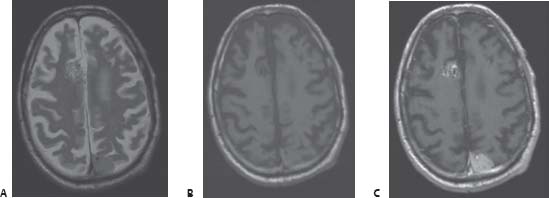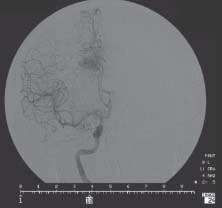Case 78 Stereotactic Radiosurgery Case Carmina M. Angeles and Dennis G. Vollmer This patient elected to undergo stereotactic radiosurgery (SRS) to both lesions. The treatment was planned for a dose of 22 Gy at 50% isodose line to the frontal arteriovenous malformation (AVM), and 16 Gy to the 50% isodose line for the dural based parietooccipital lesion. Fig. 78.1 Axial magnetic resonance images of the brain: (A) T2-weighted, (B) T1-weighted, and (C) T1-weighted with contrast. Fig. 78.2 Cerebral angiogram, left internal carotid injection, anteroposterior view.
 Clinical Presentation
Clinical Presentation
 Questions
Questions


 Answers
Answers
78 Stereotactic Radiosurgery Case
Case 78 Stereotactic Radiosurgery Case Fig. 78.1 Axial magnetic resonance images of the brain: (A) T2-weighted, (B) T1-weighted, and (C) T1-weighted with contrast. Fig. 78.2 Cerebral angiogram, left internal carotid injection, anteroposterior view.
 Clinical Presentation
Clinical Presentation
 Questions
Questions


 Answers
Answers
< div class='tao-gold-member'>
Only gold members can continue reading. Log In or Register to continue
Stay updated, free articles. Join our Telegram channel

Full access? Get Clinical Tree


